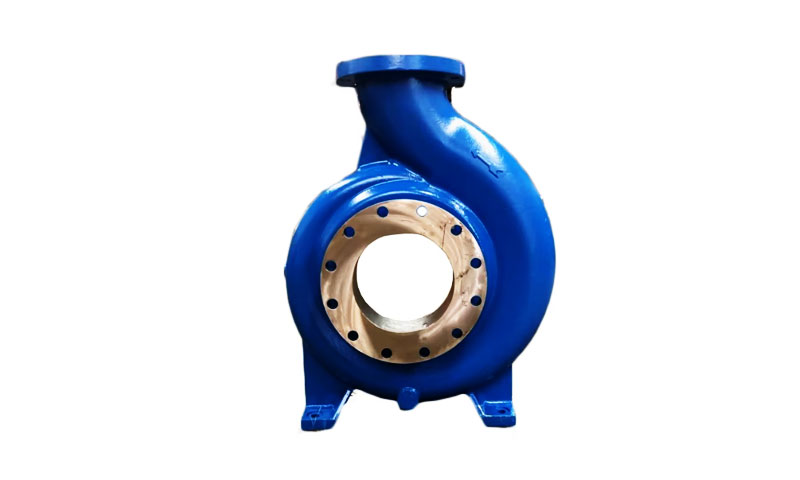1. 介绍
泵体是结构和液压壳体,可将驱动能量转化为流体运动. 它们通常包含蜗壳, 叶轮座, 轴承凸台, 法兰和内部通道.
为泵体选择的制造路线设定了可实现的几何形状, 冶金, 成本和交货时间.
熔模铸造在几何形状复杂的地方脱颖而出 (内部导流叶片, 薄网, 综合老板), 公差很严格, 和高完整性合金 (不锈钢, 镍合金, 青铜) 需要.
2. 什么是熔模铸造泵体?
定义和核心功能
一个 投资铸造 泵体 是由失蜡制成的泵壳 (投资) 铸造方法.
一种蜡 (或聚合物) 泵体的图案已创建, 涂有耐火陶瓷以构建外壳, 加热去除的蜡, 并将熔融金属倒入陶瓷模具中.
凝固后将烧制的外壳拆下,露出近净铸造泵体,随后进行加工和检查.
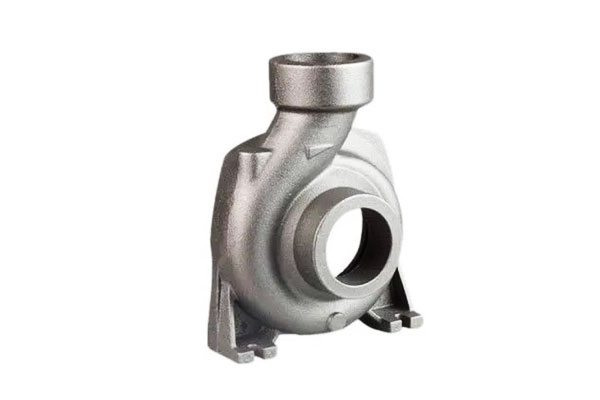
典型规格和尺寸
- 零件质量: 熔模铸造泵体通常每件重量从几百克到几十公斤不等; 许多铸造厂通常根据工厂能力铸造 ~0.5 kg 至 ~50–100 kg 的泵体.
- 壁厚: 不锈钢或镍合金的典型标称壁厚: 3–12毫米; 最小薄截面可达 1–2毫米 通过选定的合金和过程控制可以实现.
- 尺寸公差 (铸造): 一般精铸公差通常落在 ±0.1-0.5毫米 对于小特征; 基于百分比的公差 ±0.25–0.5% 线性是一个实用的经验法则.
关键的加工特征通常会留有加工余量 (0.2–2.0 mm 取决于铸造精度). - 表面饰面 (铸造): 典型Ra 1.6–3.2μm (50–125分钟) 适用于标准陶瓷外壳; 精细的贝壳和精心的浇注可以产生Ra ≈ 0.8–1.6微米.
密封面或轴承轴颈经过机械加工/研磨,达到更精细的 Ra (≤ 0.2 μm) 根据需要.
3. 设计注意事项
熔模铸造可实现复杂的几何形状, 但良好的设计实践可以最大限度地提高质量并最大限度地降低成本.
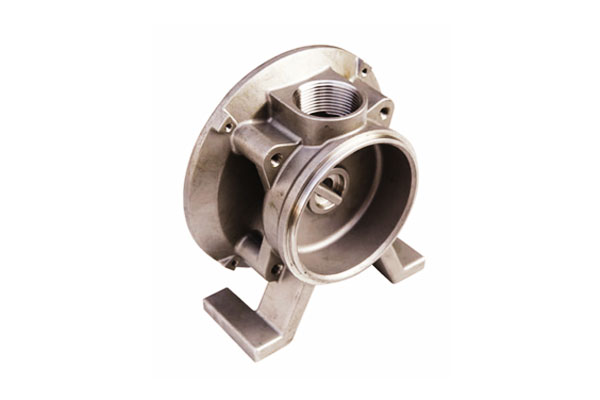
液压性能要求
- 流道 & 卷轴: 平滑的圆角和受控的收敛避免分离和气蚀.
内圆角半径应足够大 (≥ 1–2× 壁厚) 减少湍流. - 叶轮座对准: 同心度和垂直度至关重要 - 加工孔和基准特征的计划.
- 清关: 叶轮悬伸和密封面处的泵间隙必须通过后铸造加工来维持.
结构要求
- 压力 & 疲劳: 考虑循环载荷; 使用有限元分析来识别局部应力集中.
铸造冶金 (粒度, 隔离) 影响疲劳寿命——设计时避免薄, 压力很大的老板没有适当的切片. - 振动: 坚硬的腹板和肋材有助于提高固有频率; 熔模铸造允许肋骨集成到阀体中.
腐蚀 & 穿
- 材料选择: 根据流体化学选择合金 (ph, 氯化物, 侵蚀性颗粒, 温度).
海水用, 可能需要双相钢或白铜; 用于酸, 哈氏合金或适当的镍合金. - 耐侵蚀性: 光滑的内表面和牺牲涂层 (硬幕, 热喷雾) 是存在颗粒浆料的选项.
尺寸公差 & 表面饰面
- 关键功能: 指定精加工哪些面/孔并指定加工余量 (例如。, 0.5–1.5 毫米(对于沙质贝壳), 0.2–0.6 mm 用于精密外壳).
- 密封面: 指定 Ra 和平坦度; 通常研磨/抛光至 Ra ≤ 0.2 μm 和平面度以内 0.01–0.05毫米 取决于压力等级.
4. 熔模铸造泵体材料
材料选择是设计和生产熔模铸造泵体的关键因素, 因为它直接影响机械性能, 耐腐蚀性, 制造业, 和服务寿命.
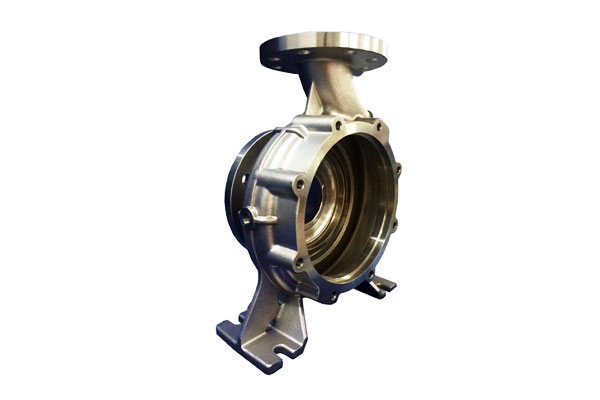
| 材料类别 | 示例合金 | 关键属性 | 典型的应用 | 铸造考虑 |
| 奥氏体 不锈钢 | 304, 316l | 优异的耐腐蚀性, 中等力量, 良好的可焊性; 拉伸: 480–620 MPA, 屈服: 170–300 MPA, 伸长: 40–60% | 通用化工泵, 水处理, 食物 & 饮料 | 熔融流动性好, 热裂风险低, 易于后加工 |
| 双工不锈钢 | 2205, 2507 | 高力量 (屈服强度 450–550 MPa), 优异的耐氯化物应力腐蚀性能 | 船用和近海泵, 积极的化学环境 | 需要控制温度; 铸后热处理以防止西格玛相 |
镍合金 |
inconel 625, 718; Hastelloy | 特殊的耐腐蚀性, 高温强度, 氧化抗性 | 化学处理, 发电, 油 & 气体 | 高熔点 (约 1450–1600 °C); 需要仔细的模具预热和控制浇注; 难加工 |
| 青铜 和铜合金 | C93200, C95400 | 优质的海水腐蚀性, 良好的耐磨性, 防污; 机械强度较低 | 海洋泵, 海水冷却, 液压成分 | 熔点较低 (约 1050–1150 °C) 简化铸造; 热裂风险低; 机械强度低于不锈钢/镍 |
5. 泵体熔模铸造工艺
熔模铸造, 也称为 迷失的蜡像, 能够生产具有复杂几何形状的泵体, 薄壁, 和高维准确性.
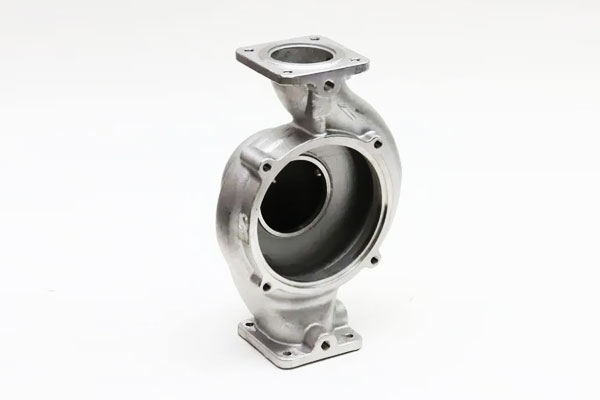
该过程由几个关键步骤组成:
| 步 | 描述 | 主要考虑因素 |
| 1. 蜡模式创建 | 将熔蜡注入精密模具中以形成泵体的复制品. | 确保壁厚均匀; 保持尺寸精度±0.1毫米; 使用优质蜡,防止变形. |
| 2. 蜡树的组装 | 单个蜡模附着在中央蜡浇道上,形成用于批量铸造的树. | 浇口设计影响金属流动; 最大限度地减少浇注过程中的湍流. |
| 3. 陶瓷外壳建筑 | 反复浸泡在陶瓷浆料中并用细耐火砂粉刷,形成坚固的, 耐热壳. | 目标壳厚度 (5–10毫米) 取决于泵体尺寸; 避免外壳出现裂纹和孔隙. |
| 4. 脱蜡和模具烧成 | 蜡已融化 (高压釜或窑炉), 离开腔; 然后对陶瓷壳进行烧制,以去除残留物并强化模具. | 必须控制温度上升以防止外壳破裂; 残留的蜡必须完全清除. |
5. 金属浇注 |
熔融金属 (不锈钢, 镍合金, 或青铜) 在重力或真空辅助条件下倒入预热的陶瓷模具中. | 浇注温度和浇注速度必须保证完全填充; 控制湍流并防止氧化物形成. |
| 6. 固化和冷却 | 金属在模具内凝固; 冷却速率影响微观结构, 机械性能, 和残余应力. | 厚截面可能需要控制冷却以防止出现孔隙; 薄壁必须避免热撕裂. |
| 7. 壳去除 | 陶瓷外壳被机械破坏, 经常使用振动, 喷砂, 或化学溶解. | 避免损坏复杂的泵通道或法兰. |
| 8. 整理和清洁 | 残留陶瓷, 浇注系统, 并通过研磨去除表面缺陷, 射击, 或化学清洗. | 保持尺寸公差; 为后续加工或涂层准备表面. |
6. 后铸造行动
泵体从陶瓷壳中取出后, 进行多次铸造后操作,以确保组件满足功能要求, 尺寸, 和表面质量要求.
这些操作对于化学领域的高性能应用至关重要, 海洋, 和工业部门.
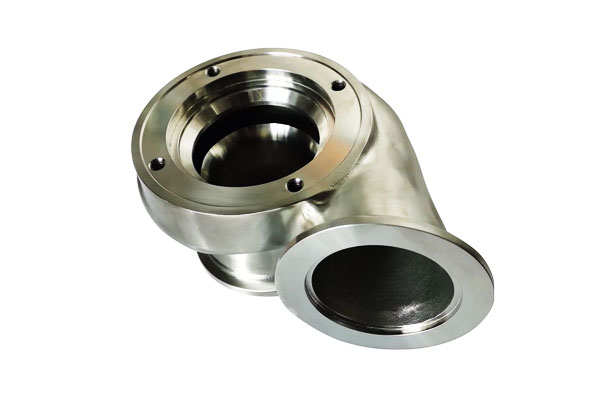
热处理
热处理 用于消除残余应力, 改善延展性, 并优化机械性能:
- 压力缓解退火: 将不锈钢加热至 550–650 °C 可减少铸造产生的残余应力并防止加工过程中变形.
- 解决方案退火: 适用于不锈钢和镍合金,使微观结构均匀化并溶解不需要的沉淀物, 确保耐腐蚀性和一致的硬度.
- 时效或沉淀硬化 (对于某些合金): 增强高性能材料的强度和耐磨性.
加工
法兰等关键尺寸, 孔, 配合面, 螺纹端口经过加工以满足严格的公差要求.
典型的加工操作包括车削, 铣削, 钻孔, 和无聊. 机加工确保:
- 尺寸公差为 ±0.05–0.1 毫米,可实现精确组装.
- 光滑的密封表面可防止高压应用中的泄漏.
表面处理
表面饰面 增强耐腐蚀性, 戴阻力, 和美学:
- 抛光: 提高密封面和内部通道的光滑度.
- 射击: 去除残留的陶瓷颗粒并形成均匀的涂层或喷漆表面.
- 涂料: 可选化学或电镀涂层 (例如。, 镍, ptfe) 增强耐腐蚀性并减少摩擦.
非破坏性测试 (NDT)
检测孔隙等缺陷, 裂缝, 或夹杂物, 进行无损检测:
- 射线照相 (X射线): 识别内部空隙和夹杂物.
- 超声测试 (UT): 检测厚截面的地下缺陷.
- 染料渗透剂测试 (pt): 显示表面裂纹和孔隙率.
清洁和检查
最后, 清洗泵体以去除残留的加工油, 碎片, 或盐. 在组装或装运前进行尺寸和目视检查以验证是否符合规格.
7. 质量保证和测试
质量保证 (质量保证) 对于确保熔模铸造泵体符合设计规范至关重要, 绩效标准, 和行业要求.
系统的质量保证方法结合了尺寸检查, 机械测试, 和无损评估以检测缺陷并确认功能完整性.
维度检查
尺寸验证确保泵体符合设计图纸和公差:
- 协调测量机 (CMM): 测量复杂的几何形状, 孔, 法兰, 和安装表面的精度为±0.01–0.05 mm.
- 测量工具: 螺纹量规, 塞规, 和高度规在生产中快速验证关键特征.
- 表面粗糙度测量: 确认密封面和内部通道的精加工要求 (例如。, 液压元件Ra≤0.8μm).
机械性能验证
机械测试验证材料满足所需的强度, 延性, 和硬度:
- 拉伸测试: 测量屈服强度, 最终的拉伸强度, 和伸长, 确保材料能够承受操作负载.
- 硬度测试: 洛氏或维氏测试证实热处理和材料加工达到了所需的硬度.
- 冲击测试 (如果需要): 评估承受波动负载或冲击的应用的韧性.
非破坏性测试 (NDT)
NDT 技术可在不损坏零件的情况下检测隐藏的缺陷:
- 射线照相 (X 射线/CT 扫描): 识别内部孔隙度, 包含, 和空隙, 特别是在较厚的部分.
- 超声测试 (UT): 检测内部裂纹, 空隙, 或不锈钢和镍合金等致密材料的分层.
- 染料渗透剂测试 (pt): 显示表面裂纹, 针孔, 或肉眼不可见的细小孔隙.
- 磁性粒子测试 (公吨): 应用于铁磁合金以检测表面和近表面不连续性.
常见铸造缺陷及缓解策略
- 孔隙率: 通过适当的门控最小化, 排气, 和受控的凝固速率.
- 收缩腔: 通过立管设计和热管理解决.
- 冷关: 通过在复杂的几何形状中保持最佳浇注温度和平稳流动来避免.
- 表面夹杂物: 通过使用高纯度合金和适当的脱气技术进行控制.
8. 泵体熔模铸造的优点
- 复杂的几何形状: 内部段落, 薄壁和集成凸台,二次组装最少.
- 近网状: 减少材料去除量. 对棒材或钢坯进行粗加工——通常 30– 加工量减少 70% 用于复杂的零件.
- 高维精度 & 表面饰面: 与砂型铸造相比,许多特征的二次精加工更少.
- 合金灵活性: 铸造许多具有良好冶金完整性的不锈钢和镍合金.
- 中小型生产灵活性: 与蜡模相比,蜡模模具相对便宜. 大型模具, 实现从原型到数千个零件的经济运行.
9. 局限性和挑战
- 非常大的零件的成本: 超过一定尺寸 (经常 >100 公斤) 与砂型铸造或制造/焊接相比,熔模铸造变得不经济.
- 交货时间: 图案工具, 炮弹建造和发射增加了交付时间——原型时间表通常以周为单位.
- 厚截面的孔隙风险: 厚凸台或大横截面需要仔细浇注, 冷却或分段以避免收缩.
- 表面光洁度和公差取决于外壳系统: 实现超精细的表面处理或极其严格的铸态公差需要优质的陶瓷系统和过程控制.
10. 工业应用
熔模铸造泵体因其优异的性能而被广泛应用于各个行业。 复杂的几何功能, 物质多功能性, 和高维准确性.
该过程允许工程师设计优化的液压通道, 薄壁, 和集成安装功能可提高泵效率和使用寿命.
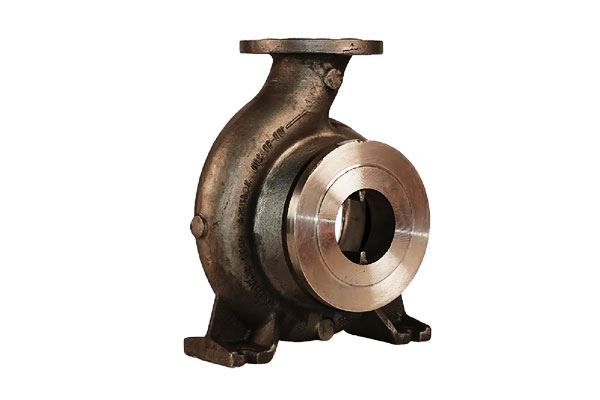
化学加工泵
- 环境: 腐蚀性液体,例如酸, 焦散, 和溶剂.
- 使用材料: 不锈钢 (316l, 双工) 和镍合金 (Hastelloy, inconel).
- 理由: 熔模铸造实现了复杂的内部渠道, 最大限度地减少湍流并确保均匀流动, 对于化学过程的可靠性至关重要.
水泵和废水泵
- 环境: 大容量泵送, 磨蚀性悬浮固体, 和可变的 pH 值.
- 使用材料: 青铜, 双工不锈钢, 和耐腐蚀铸铁.
- 理由: 薄壁, 光滑的内部通道减少堵塞和能量损失, 提高市政和工业供水系统的效率.
船用和近海泵
- 环境: 盐水暴露, 高压操作, 和周期性机械应力.
- 使用材料: 铜合金 (海军黄铜, 青铜), 双工不锈钢.
- 理由: 耐腐蚀和耐生物污垢至关重要; 熔模铸造可实现无缝, 复杂的几何形状可减少维护并提高使用寿命.
油 & 燃气和发电泵
- 环境: 高温, 高压流体, 和碳氢化合物介质.
- 使用材料: 高镍合金 (inconel, Hastelloy), 不锈钢, 和钴基合金.
- 理由: 熔模铸造支持涡轮机润滑等关键应用所需的高强度材料和精确公差, 化学注射, 和海上钻探.
特种和定制泵
- 环境: 实验室, 药物, 或需要卫生和精密性能的食品加工应用.
- 使用材料: 不锈钢 (304, 316l), 钛, 或镍合金.
- 理由: 光滑的表面, 严格的公差, 通过熔模铸造实现的复杂几何形状可确保污染风险最小化并符合监管标准.
11. 比较分析
| 特征 / 标准 | 熔模铸造 | 沙子铸造 | 实体加工 |
| 几何复杂性 | 优秀——薄壁, 内部频道, 可实现复杂的功能 | 中等 – 受到型芯放置和模具稳定性的限制 | 有限——复杂的内部几何形状通常不可能在不组装的情况下实现 |
| 维度的准确性 | 高 – ±0.1–0.25 mm(典型值) | 中等 – ±0.5–1.0 毫米 | 非常高 – 可达到 ±0.05 mm |
| 表面处理 (RA) | 精细 – 1.6–3.2 μm(典型值); 可以抛光 | 粗糙 – 6–12 μm; 需要进行精密加工 | 优秀 – 通过精加工可达到 0.8–1.6 μm |
| 材料选择 | 宽幅 – 不锈钢, 镍合金, 青铜, 铜合金 | 宽幅-铁, 钢, 青铜, 铝 | 宽 – 取决于可加工库存的可用性 |
| 批量大小 | 低到中 – 1–1000+ 零件 | 中到高——对于大型企业来说经济实惠, 简单零件 | 低——材料浪费增加了大型零件的成本 |
| 交货时间 | 中等——蜡模 & 需要建造外壳 | 短到中等——模具准备相对较快 | 变量 – 取决于加工复杂性 |
物质浪费 |
低——近净形状减少废品 | 中等 – 浇口和冒口会产生一些废物 | 高 – 减材工艺会产生切屑和边角料 |
| 每部分费用 | 中到高 – 工具和工艺步骤会增加成本, 对于复杂零件来说经济实惠 | 低到中等——更简单的模具, 较大的零件更便宜 | 高——大型加工, 复杂的零件价格昂贵 |
| 力量 & 正直 | 优秀——致密的微观结构, 如果控制的话,孔隙率最小 | 中等 – 与砂相关的夹杂物和孔隙度的风险 | 优秀——均匀, 没有铸造缺陷 |
| 需要后期处理 | 通常是最小的——一些机械加工, 精加工 | 通常很重要——需要加工和精加工 | 最小化——仅针对严格公差的最终精加工 |
| 典型的应用 | 薄壁泵体, 复杂的液压通道, 耐腐蚀性 | 大的, 简单的泵壳或结构部件 | 需要极高精度的定制或原型泵体 |
12. 结论
熔模铸造泵体将设计自由度与冶金完整性结合在一起, 使它们成为许多流体处理应用的绝佳选择,尤其是在复杂的内部几何形状的情况下, 需要特殊合金或严格的公差.
成功取决于铸造的早期设计, 知情的材料选择, 仔细的过程控制 (浇注, 炮击, 热处理), 和强大的 QA/NDT 计划.
对于关键泵系统——船舶, 化学或发电——熔模铸造可以提供可靠的, 正确指定和执行时的经济组件.
常见问题解答
熔模铸造泵体最大尺寸是多少?
典型的车间实践范围为每个零件约 50–100 公斤, 但实际的最大值取决于铸造能力和经济性.
非常大的泵体通常通过砂型铸造或制造/焊接来生产.
熔模铸造应设计多少加工余量?
允许 0.2–2.0毫米 取决于关键程度和外壳精度. 仅在铸造厂保证精密外壳的情况下指定更严格的余量.
海水泵体哪种材料最好?
双相不锈钢和精选的铜镍合金具有优异的耐氯化物点蚀和生物污垢性能,是常见的选择; 最终选择取决于温度, 速度和侵蚀条件.
熔模铸造泵体的典型周转时间是多少?
小批量生产通常需要 4–8周 从样板批准到成品零件; 使用 3D 打印模型可以更快地制作单个原型,但仍然需要炮弹点火和熔化时间表.
如何指定孔隙率的验收标准?
使用行业无损检测标准 (射线照相, CT, UT) 并以体积百分比孔隙率或通过参考图像定义验收水平.
临界压力保持泵体通常需要孔隙率 <0.5% 根据客户标准的体积和射线照相可接受性.
